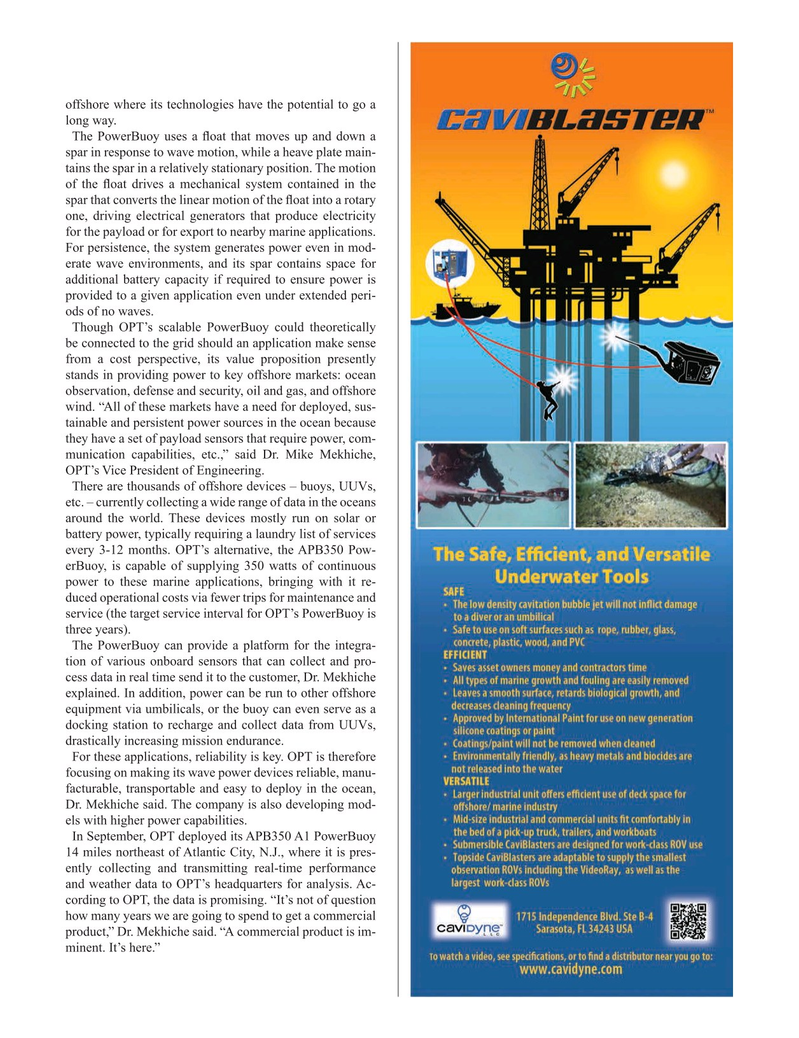
Page 19: of Marine Technology Magazine (November 2015)
Read this page in Pdf, Flash or Html5 edition of November 2015 Marine Technology Magazine
offshore where its technologies have the potential to go a long way.
The PowerBuoy uses a ? oat that moves up and down a spar in response to wave motion, while a heave plate main- tains the spar in a relatively stationary position. The motion of the ? oat drives a mechanical system contained in the spar that converts the linear motion of the ? oat into a rotary one, driving electrical generators that produce electricity for the payload or for export to nearby marine applications.
For persistence, the system generates power even in mod- erate wave environments, and its spar contains space for additional battery capacity if required to ensure power is provided to a given application even under extended peri- ods of no waves.
Though OPT’s scalable PowerBuoy could theoretically be connected to the grid should an application make sense from a cost perspective, its value proposition presently stands in providing power to key offshore markets: ocean observation, defense and security, oil and gas, and offshore wind. “All of these markets have a need for deployed, sus- tainable and persistent power sources in the ocean because they have a set of payload sensors that require power, com- munication capabilities, etc.,” said Dr. Mike Mekhiche,
OPT’s Vice President of Engineering.
There are thousands of offshore devices – buoys, UUVs, etc. – currently collecting a wide range of data in the oceans around the world. These devices mostly run on solar or battery power, typically requiring a laundry list of services every 3-12 months. OPT’s alternative, the APB350 Pow- erBuoy, is capable of supplying 350 watts of continuous power to these marine applications, bringing with it re- duced operational costs via fewer trips for maintenance and service (the target service interval for OPT’s PowerBuoy is three years).
The PowerBuoy can provide a platform for the integra- tion of various onboard sensors that can collect and pro- cess data in real time send it to the customer, Dr. Mekhiche explained. In addition, power can be run to other offshore equipment via umbilicals, or the buoy can even serve as a docking station to recharge and collect data from UUVs, drastically increasing mission endurance.
For these applications, reliability is key. OPT is therefore focusing on making its wave power devices reliable, manu- facturable, transportable and easy to deploy in the ocean,
Dr. Mekhiche said. The company is also developing mod- els with higher power capabilities.
In September, OPT deployed its APB350 A1 PowerBuoy 14 miles northeast of Atlantic City, N.J., where it is pres- ently collecting and transmitting real-time performance and weather data to OPT’s headquarters for analysis. Ac- cording to OPT, the data is promising. “It’s not of question how many years we are going to spend to get a commercial product,” Dr. Mekhiche said. “A commercial product is im- minent. It’s here.”
MTR #9 (18-33).indd 19 12/8/2015 10:24:15 AM

 18
18

 20
20
